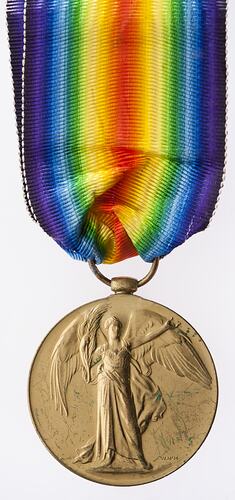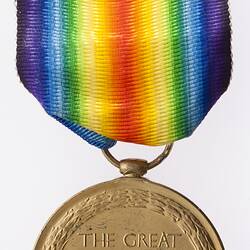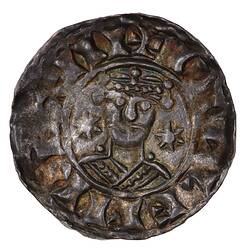Summary
Victory Medal 1914-1919 with ring mount and ribbon awarded to Sgt. George Foster, service number 1267, 16th Battalion, A.I.F.
George Foster, an immigrant from England, was a 24-year-old labourer when he joined at Morphetville, South Australia on 12 September 1914. His mother in South Australia was initially cited as his next of kin, but later her name was crossed out and substituted with the name of his wife Julia, who lived in London.
George embarked from Melbourne on the HMAT Ceramic on 22 December 1914, bound for Egypt. After several months there, he was part of the early landings on Gallipoli. His service record states that he was wounded there on 28 April 1915 (two days later than the donation note suggests). His wound was later described as a gunshot wound to the 'left loin'. His wound was sufficiently severe for him to be sent to England by hospital ship. By September he was able to return to his unit in Mudros, where on 29 October he was promoted to sergeant. From there he was apparently sent back to the Dardenelles front, as his wife later writes that he was involved in the evacuation of Gallipoli.
Back in Egypt in May 1916, George was reported to be suffering from venereal disease, later corrected and described instead as 'ademitus of idropathic inguinal' (an undefined groin condition with swelling). He spent several weeks in hospital. On 8 September 1916 he was sent back to England, and on 16 September he was in France. He survived there just four months. Sergeant George Foster was killed in action on 15 January 1917, at Gueudecourt, near Bapaume, France. He was buried at Grass Lane, Gueudecourt. His personal items were sent to his wife: mittens, cap comforter, sergeant's chevrons, whistle, purse, four notebooks, wallet, letters, cards, photos and two coins. She later moved to South Australia.
The Victory Medal was authorised in 1919 and was awarded to army, navy and air force personnel who served in a theatre of war between midnight 4th-5th August 1914 and midnight 11th-12th November 1918. The Allies resolved that, if they wished to issue a Victory Medal, it would share a common feature of a depiction of Victory on the obverse and a ribbon of red, yellow, green, blue and violet merged into a rainbow pattern. This medal, that of Great Britain, was awarded to personnel from countries in the British Empire (some 5,725,000 were issued). The other Allied countries that issued Victory medals were: Belgium, Brazil, Cuba, Czechoslovakia, France, Greece, Italy, Japan, Portugal, Romania, Thailand, Union of South Africa and the United States of America.
Obverse Description
Figure of Victory facing three-quarters right with wings spread; in her right hand she holds a palm branch, her left hand is extended and open. The artist's initials, W.McM. (W. McMillan) are above the ground line on the right.
Reverse Description
The words, 'THE GREAT . WAR FOR . CIVILISATION 1914-1919' within a circular wreath of laurel.
Edge Description
Text; '1267 SGT. G. FOSTER 16 BN. A.I.F.'.
More Information
-
Collection Names
-
Collecting Areas
-
Acquisition Information
Donation & Subsequent Transfer from Victorian Branch, Returned & Services League of Australia Limited (RSL), Mrs J. E. Foster, Jan 1984
-
Date Issued
1919 AD
-
Issued By
-
Mint
-
Artist
-
Awarded To
Sergeant George Foster - Australian Imperial Force (AIF), Australia, 1919
1267 Sgt G. Foster, 16th Battalion, A.I.F. -
Place
Gallipoli Peninsula, Turkey
Place medal recepient served -
Inscriptions
Obverse; 'W.McM.' (W. McMillan- artist). Reverse; 'THE GREAT . WAR FOR . CIVILISATION 1914 - 1919'. Edge; '1267 SGT. G. FOSTER 16 BN. A.I.F.'.
-
Material
Bronze
-
Axis
12
-
Classification
-
Category
-
Discipline
-
Type of item
-
Overall Dimensions
50 mm (Height), 36 mm (Outside Diameter)
Height to top of ring.
-
Shape
Round with loop and ribbon
-
References
References: [Link 1] National Archives records for George Foster - barcode 4023474.
[Book] Joslin, E C., et al. 1988. British Battles and Medals., 230 - 1 Pages
-
Keywords






